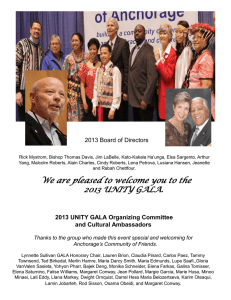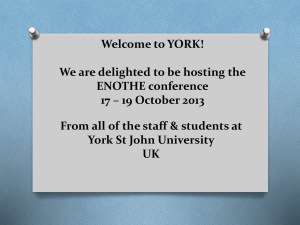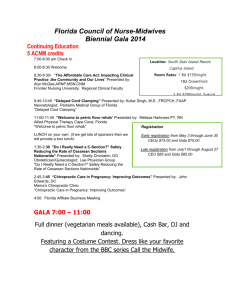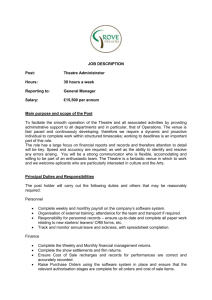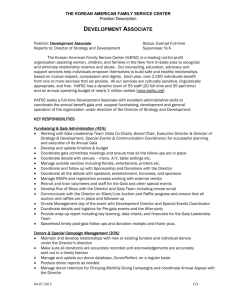Multi Purpose Hall | Flexible floor from stage to raked floor for
advertisement
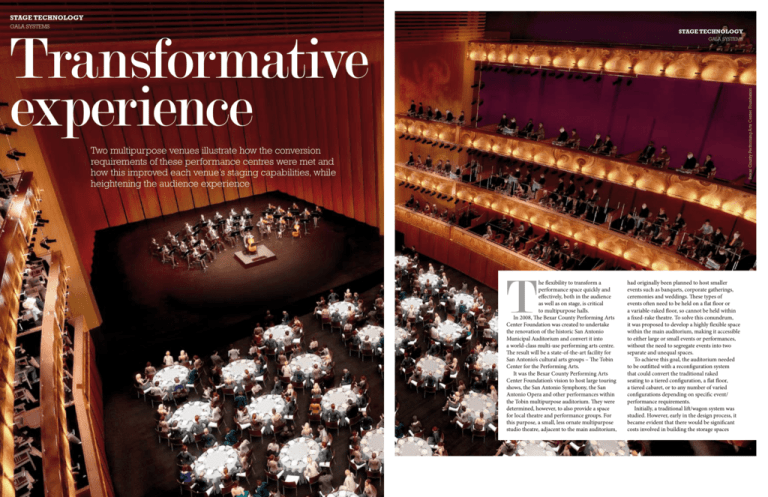
Stage technology gala sysTems Stage technology Transformative experience Bexar County Performing arts Center Foundation gala sysTems Two multipurpose venues illustrate how the conversion requirements of these performance centres were met and how this improved each venue’s staging capabilities, while heightening the audience experience T he flexibility to transform a performance space quickly and effectively, both in the audience as well as on stage, is critical to multipurpose halls. In 2008, The Bexar County Performing Arts Center Foundation was created to undertake the renovation of the historic San Antonio Municipal Auditorium and convert it into a world-class multi-use performing arts centre. The result will be a state-of-the-art facility for San Antonio’s cultural arts groups – The Tobin Center for the Performing Arts. It was the Bexar County Performing Arts Center Foundation’s vision to host large touring shows, the San Antonio Symphony, the San Antonio Opera and other performances within the Tobin multipurpose auditorium. They were determined, however, to also provide a space for local theatre and performance groups. For this purpose, a small, less ornate multipurpose studio theatre, adjacent to the main auditorium, had originally been planned to host smaller events such as banquets, corporate gatherings, ceremonies and weddings. These types of events often need to be held on a flat floor or a variable-raked floor, so cannot be held within a fixed-rake theatre. To solve this conundrum, it was proposed to develop a highly flexible space within the main auditorium, making it accessible to either large or small events or performances, without the need to segregate events into two separate and unequal spaces. To achieve this goal, the auditorium needed to be outfitted with a reconfiguration system that could convert the traditional raked seating to a tiered configuration, a flat floor, a tiered cabaret, or to any number of varied configurations depending on specific event/ performance requirements. Initially, a traditional lift/wagon system was studied. However, early in the design process, it became evident that there would be significant costs involved in building the storage spaces audiToria annual 2012 109 Bexar County Performing arts Center Foundation Stage technology Photo: Timothy Hursley gala sysTems Mark Reddington, a principal of LMN Architects, speaking to Scott Andrews of the San Antonio Current newspaper, comments that this is “a terrific amenity for the community”. Kauffman center the Kauffman center for the Performing arts (above); the tobin center for the Performing arts (right) 110 audiToria annual 2012 required for the lifts and wagons under the audience floor level as the water tables are high because the Tobin Center is located next to a river walk canal. Also, and most importantly, the number of configurations was limited and the time required for transformation was significant. FDA, the theatre consultant, proposed that an alternate solution – an automated floorriser/transformable-seat system – be studied. The versatility of this type of individual-row, seat-riser system provides the diversity and speed of changeover required to suit the various event requirements. Given that quick overnight or midday conversions were possible with this system, it would be possible for the venue to be filled to near-capacity all year round. It was also brought forward that in many other multipurpose venues, many events required alternate seating plans, flat-floor or variablefloor configurations rather than an Italian raked-seat auditorium. Ultimately, the Gala Venue system, provided by Gala Systems, was selected by the foundation because it is a proven system (deployed in a number of multipurpose venues around the world) and permits every row of seats to be quickly stored or deployed individually and automatically, without the need to dig a deep pit area. The inherent features of the Gala Venue system allow for a larger variety of configurations within the allotted space than a lift/wagon system, without sacrificing audience comfort and accessibility. The high speed of transformation – about 15 minutes – enables quick overnight or midday conversion of the space. The extra flexibility and speed of conversion, as well as the confidence of having multiple venues integrated with the Gala Venue, convinced the Tobin Center Foundation to choose this system. Opened on 16 September 2011 with a grand opening gala to inaugurate its two new performance halls, the Kauffman Center for the Performing Arts in Kansas City, Missouri is now a centre for music, opera, theatre and dance. Built at a cost of US$415 million, the 26,500m2 facility is one of the most technically advanced performing arts centres in the country, allowing the staging of elaborate works and encouraging interdisciplinary collaboration. The Kansas City Lyric Theatre, the Kansas City Ballet and the Kansas City Symphony will all be moving to the new Kauffman Center. The programming will include pop music, film, pop concerts, ballet, opera, plus Symphony and Broadway type shows. For the 1,600-seat Helzberg Hall, the transformable challenge was really to find a balance between the acoustic and technical performance requirements. Nagata Acoustics wanted the shapes of the lifts to mimic a musical instrument so that the concert hall could be ‘tuned’ for different types of performances. To address this, Gala Systems’ Spiralift lift system was deployed enabling the lifts to be automated in conjunction with an overhead canopy, so that the layout of the stage could be quickly and easily altered to accommodate the acoustical requirements of solo concerts, chamber music or even full orchestras. For the 1,800-seat Muriel Kauffman Theatre’s expanded facilities, Gala System’s Spiralift system was deployed to support a flexible proscenium opening and sound mix lifts reconfigurable for both intimate and larger-scale productions. These projects illustrate perfectly how venue flexibility can be enhanced with space reconfiguration technology. n www.galasystems.com http://tobincenter.org/ www.kauffmancenter.org/
